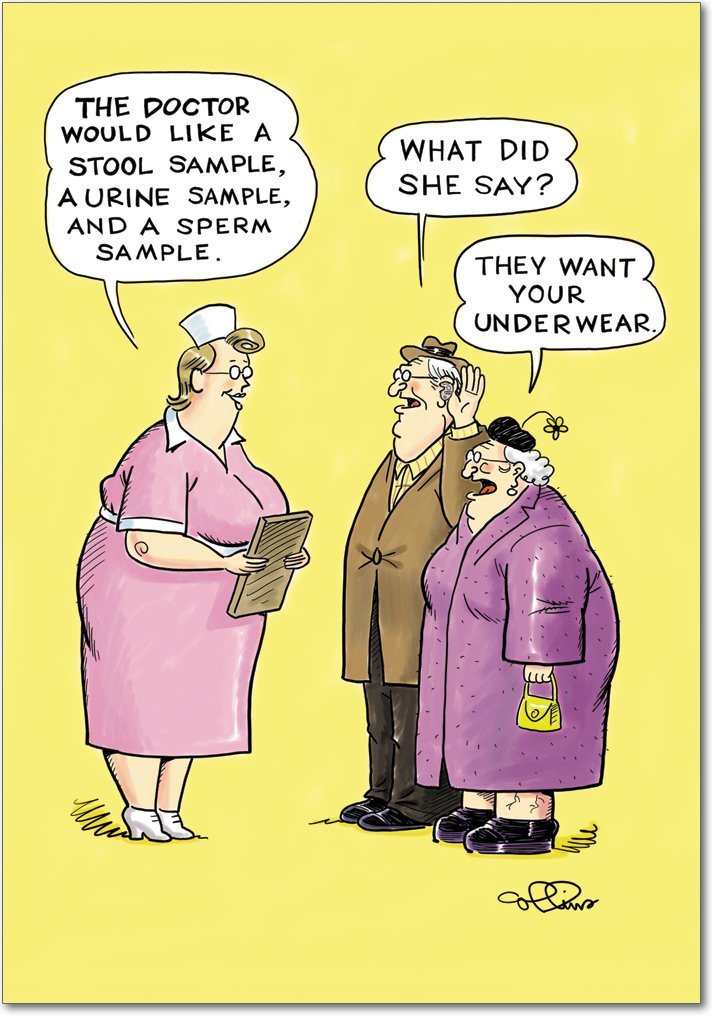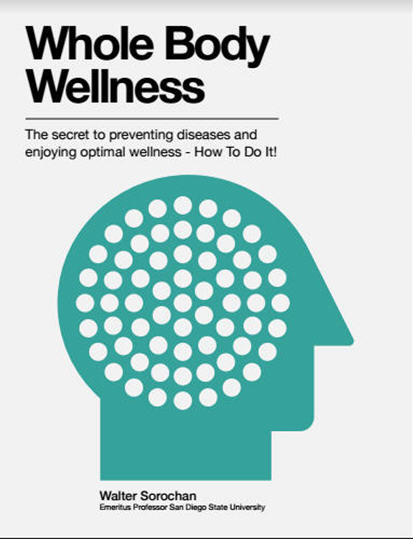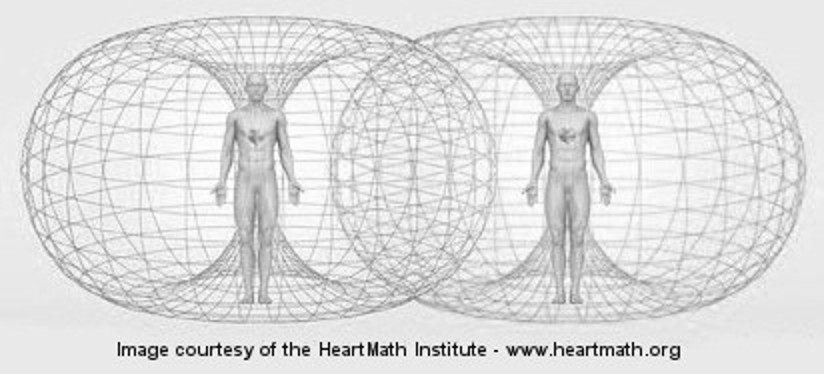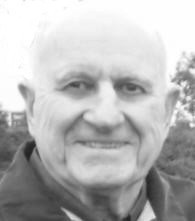Whole Body Wellness
You have come to the right place!

The cartoon illustrates the health and life problems people have. Like hearing loss, overweight/obesity, joint pain or arthritis, frequent colds and flu, high blood pressure, cancer, skin problems like acne, menstrual pain and so on. Most if not all of these body problems can be be prevented or minimized. This is what the book is about.
Ladies can minimize menstrual pain with good nutrients. Learn how to lose fat weight and keep it off. Everyone can minimize the muscle cramps and joint pain for these are signs of nutritional deficiencies that can be easily corrected. Prevent flu, colds and high blood pressure with select nutrition. Enhance your immunity. You can prevent acne and have radiant skin. You can help harness the body's natural ability to detoxify toxins that are poisoning you.
Now is an opportune time to give yourself and others a disease prevention gift, regain better wellbeing and discover the many secrets and mysteries of your body that your doctors never tell you. Here are a few:
- The body rebuilds itself regularly and it can heal itself without drugs.
- A person may go through his/her entire life nutritionally deficient or unbalanced and not know it while socializing, enjoying physical, mental and emotional activities.
- The most important role of iodine is in maintaining the proper function of mammary and other glands, tissues and cells in the body; preventing goiter is secondary.
- Food has real information that is carried as exosomes [DNA determiners of health and disease].
- A low blood level of hormone D is the reason people are vulnerable to cold and flu viruses.
- Vitamin C has to be replaced several times a day.
- When you eat junk foods you also feed the bad bacteria in your colon [that can make you sick].
- There is a built-in chemical process in our body that determines us being healthy or sick. This commander of your body is methylation.
- You have thousands of body sensors that can detect the status of your health.
- Our human body has a built in lymphatic system that does body cleansing better than any commercial de-tox program.
- Cancer can go into remission in a body site. But cancer cannot be cured.
- Reflux can be prevented without drugs.
- The brain and mind can light up learning from birth to senior citizens. The brain has plasticity, referring to the brain's ability to CHANGE throughout life. The brain-mind wants to learn.
- There is a link between constipation and the kind of food you eat.
You can also reverse, at any age, what you did wrong early in life and readjust the chemistry of the body back to a better working wellness level. You can become a new you and regain a disease free body. Find out how you, not doctors, can do all this. Taking life and health for granted does not work. You need to maintain your body just as you need to maintain your car.
The gift is a paperback or e-book that provides information you need to know and do in order to prevent diseases. The paperback helps you to understand what is happening in your body and how to prevent incubating chronic diseases. Being disease free extends life and helps you get optimal wellbeing, a better chance for excellence in all your endeavors and more success in life. Each day you postpone such a gift brings you a step closer to a disease and poor health.

While reading the many chapters, you will learn how the body works and heals, that food is your best medicine, how to select good foods to change the chemistry of your body, and what you need to do [prevent] to help you stay well.
But there is a catch! You can not prevent if you do not know. In order to prevent a disease, you need to know what causes you to get sick and how the body works when you are sick. Knowing gives you a chance to prevent and heal. Whole Body Wellness provides all this information.
The theme of this book is more than just taking back your health from the care of your doctor. Prevention is a revolutionary approach to a new way of life that eventuates in better wellbeing. Health comes from how you live, your lifestyle, and not from the doctor taking care of you. In these uncertain economic times and the instability of the health care system, we need to re-learn how to take care of ourselves and spend less money on health care but at the same time enjoy better health. This book shows you how to prevent, how to self-heal and use the doctor as a backup when needed. But .... you need to read the book to find out more!
You can view 4 chapters on Amazon website to help you decide on buying the book.
Contact Author - Author has no vested interests and sells no products. Your feedback is most appreciated: E-mail author
To buy this book on Amazon, you need to open an Amazon account first, then Click Amazon website to display Amazon online, review the free chapters and then order: Whole Body Wellness.
Thank you for your patience and consideration.
Below is a free sample Chapter: [more chapters on Amazon website] It shows you how to prevent cardiovascular diseases [CVD].
Chapter 27: CVS - Prevention is a more political than medical
The heart is a marvelous, delicate and precise machine. We have been taught that the heart is a pump that circulates the blood throughout the body. Less known is that the heart has its own pace-maker. The heart generates a mysterious and powerful electromagnetic field. It has it's own brain, so to speak, and sends messages to the brain. "The heart is a sensory organ and acts as a sophisticated information encoding and processing center that enables it to learn, remember, and make independent functional decisions.” Indeed, the heart also resonates or beats to the rhythmic beat of the earth. [1] [2] [3]
The heart works best when it gets an ample amount of oxygen and nutrients. But when the heart is exposed to the wrong food or a lack of a ratio balance in nutrients, primarily magnesium to calcium, over a long period of time, then it reacts by depositing calcium in the arteries, thereby narrowing the small blood vessels that supply blood and oxygen to the heart. Possible symptoms may include chest pain and tightness, high blood pressure, shortness of breath, weakness and pain in one side of the body, slurred speech, lack of balance and trouble walking, vision problems and confusion. These symptoms could indicate a number of heart problems referred to as coronary artery disease, or heart disease. Sadly, about 60 percent of persons, who appear to be well and had no previous symptoms, die suddenly. [4]
How heart and blood circulation work: Blood that flows through arteries carries red blood cells that deliver oxygen to nearby cells. Blood also delivers water, nutrients, and minerals to all the cells in the body, while removing carbon dioxide and excess waste material. So an interruption of blood supply has serious consequences because every cell in the body needs oxygen, water, nutrients and minerals to survive. This lack of oxygen, referred to medically as ischemia, can occur in any part of the body, and when it occurs in the brain, it is called an ischemic stroke. [5] [6]
The American Heart Association notes that the majority [estimated 80 percent] of cardiovascular diseases [CVD] can be entirely prevented. [7] [8]
The first approach to prevention is to be aware of the symptoms of a heart attack or stroke: [9] [10]
- Weakness of one side of the body
- Numbness, tingling or unusual sensations
- Trouble walking
- Coordination problems
- Vision loss or decrease in vision
- Blurred vision or double vision
- Slurred speech
- Trouble communicating
- Face asymmetry
- Droopy eyelid
- Dizziness
- Headache
- Confusion
The next most important preventive approach is to be aware that there are two nutrients, hormone D [11] and magnesium, that can help prevent hypertension and congestive heart failure. Hormone D has an important supporting role in cardiovascular health. You can get more information about hormone D in Chapter 10 and magnesium in Chapter 9.
Magnesium is a major player in preventing cardiovascular disorders.
Many researchers agree that magnesium can prevent cardiovascular diseases:
Physician-researcher Carolyn Dean points out that previous medical practice of telling diagnosed heart disease patients to steer clear of full-fat dairy items loaded with saturated fat was bad advice. A decade-long study that reviewed cardiovascular disease research extending over more than 70 years found that low magnesium levels contributed more to heart disease than did cholesterol or even saturated fat. [5]
There are also many peer-reviewed studies that show correcting or preventing a nutritional magnesium deficit can and will correct or prevent cardiovascular disease events, including death. [5] [12] [13] Researcher, Andrea Rosanoff, PhD, director of research and science information outreach for the Center for Magnesium Education & Research, LLC, in Pahoa, Hawaii, and a medical advisory board member for the nonprofit Nutritional Magnesium Association, found that "common risk factors for cardiovascular disease such as high LDL cholesterol, low HDL cholesterol, high blood pressure, and metabolic syndrome are all associated with low nutritional magnesium status or low magnesium dietary intakes."
“We’ve been using cholesterol-lowering drugs for several decades now, and there has only been an increase in heart disease and no decrease,” Dr. Carolyn Dean, M.D., adds. “If cholesterol was the problem and statin drugs the solution, there should be a commensurate lowering of the incidence of this condition.” [5] [14]
How magnesium intake influences heart health: Magnesium, in adequate amount, prevents calcium deposits in the arteries: Magnesium opens the door for calcium to be allowed into muscle cells to cause contraction, then, magnesium ushers excess calcium out of the cell. When magnesium is in short supply, calcium floods the heart cells and leads to hyper-contraction of the muscle cells, causing angina and even heart attack. [5] [15]
While the above information sounds good, there is a major flaw in accepting magnesium as a life savior. The body needs a delicate ratio balance of magnesium to calcium in order for both minerals to work properly. At this time this ratio is controversial. Best guess is that this ratio should be CA:Mg = 2:1. Calcium and magnesium have opposite effects on the heart and muscles. For example, excess of calcium can cause muscle cramps while magnesium relaxes muscles. [15] [16] But excess calcium intake by itself causes excess calcium deposits in arteries, causing atherosclerosis and muscle cramps.
Another flaw in using magnesium to prevent heart disease is that magnesium does not work by itself! It requires many co-factors to help it do its job in the body.
A major reason that many are deficient in magnesium is that 70 to 80 percent of magnesium ingested from food or supplements is not absorbed in the digestive system.
Magnesium is absolutely essential for the proper functioning of the heart. Heart surgeons have now recognized the importance of magnesium in controlling the heart for a long time. Heart patients scheduled for surgery are now given magnesium before and after surgery for several reasons: magnesium can help alleviate pain, decrease blood pressure and alleviate certain heart arrhythmias. Magnesium works to prevent blood clotting, relieves depression so common after bypass surgery, and improves energy and cognitive abilities. [5] [ [15] [16] [17] [18] [19] [20] [21] Magnesium is a natural calcium blocker, but this goes unrecognized by most physicians. [22]
Doctors now recognize that magnesium needs to be balanced by a proper amount of calcium. Excessive calcium and a shortage of magnesium intake are difficult to balance. Modern medicines' answer to the problem is to prescribe billions of dollars of calcium-blocker drugs. [22
While attention about magnesium is centered about preventing cardiovascular disorders, overlooked is that all body somatic cells need magnesium. [18] [23] Magnesium is found in amino acids and performs over 300 different body functions.
For more information about magnesium, refer to Chapter 9, Magnesium.
Although there may be heart and cardiovascular problems, we should not overlook the marvels of the heart.
Heart is an electric generator: The graphic illustration below shows that the heart sends electrical waves outside the body and that these waves can act as "heart to heart" emotions that can be sensed by those nearby.
The heart senses feelings of nearby persons: Ever get the feeling that a certain person or opposite sex finds you attractive? Woooh, a heartthrob! It is your heart silently communicating. Rolin McCraty, Director of Research at HeartMath Institute, explains this real happening by pointing out that Earth’s own magnetic field might be aiding this transmission of signals between people. “The earth’s magnetic field is a carrier wave of biologically relevant information,” he says. “This is what connects us all. It’s also part of the intuition: how a mom knows her son or daughter is distressed on the other side of the planet. Something has to be conveying that information, which often seems to happen almost instantaneously. My [McCraty] hypothesis is that this is literally the magnetic field of the earth, and there is a fair amount of support on that.” [1]

The heart actually produces a toroidal-shaped [donut] electromagnetic field identical to the one produced by the Earth, that extends up to fifteen feet outside of our bodies [refer to illustration above]. Medical doctors can pick up this electrical field and record it as an electocardiogram or EKG.
Heart has its own brain: Far more than a simple pump, as was once believed, the heart is now recognized by scientists as a highly complex system with its own functional “brain.” [1] It can compensate and adjust when the body needs to support stress, running or other activity by speeding or slowing the heart rate as needed.
How Can Coronary Heart Disease Be Prevented or Delayed?
Prevention of CVD:
While there is nothing you can do about your age or family history, you can control life style behaviors and prevent cardiovascular disorders: [6] [7] [9] [24] [25] [26]
- 1. Choose a healthy diet: eat fresh fruits and vegetables, lean meat like chicken or turkey, nuts, seeds, legumes like beans, whole grains. [27]
Eat good foods that provide food for the good bacteria in the colon.
New test for CVD: Arterial stiffness [hardening of arteries] may be a good indicator of vascular health and should be monitored throughout life. There is now a simple and affordable test to evaluate the stiffness [hardening of the arteries] between aortic stiffness and early brain damage. The test, Wave Velocity [PWV], and MRI are ways to predict heart disease in those who appear to be healthy.
A few studies show that stiffening of the arteries might happen to us a lot sooner than we previously believed. According to research led by the UC Davis School of Medicine, healthy individuals in their 40s can already show hardening of arteries. The condition can cause subtle brain injuries, which have been related to slow cognitive decline and Alzheimers later in life. [22]
In other words, participants with more pronounced aortic stiffness had negative changes in their white and grey brain matter using MRI imaging. Addressing arterial stiffness early in life could help preserve brain health as well as reduce morbidity and mortality connected with various cardiovascular causes.
Dr. Hirofumi Tanaka, the director of the Cardiovascular Aging Research Laboratory at the University of Texas, and others [30] [31] performed a study that included a sample of healthy men and showed that arterial stiffness increased with age in people with a sedentary life style. [29]
References Chapter 26 CVS:
1 McCraty Rollin, Raymond Trevor Bradley and Dana Tomasino, "The Heart Has Its Own ‘Brain’ and Consciousness," Esoteric, Metaphysical and Spiritual Database, January 10, 2015. Retrieved from http://in5d.com/the-heart-has-its-own-brain-and-consciousness/
2 Cassini Monica, " The Heart Has Its Own “Brain” and Consciousness," Everythimh Matters Beyond meds, December 18, 2012. Retrieved from https://beyondmeds.com/2012/12/18/the-heart-has-its-own-brain-and-consciousness/
3 Decker Ed, "ROLLIN MCCRATY: CLOSING THE GAP BETWEEN HEART AND BRAIN," Rewire Me. Retrieved from https://www.rewireme.com/insight/rollin-mccraty-closing-gap-heart-brain/
4 Corriher Sarah C., "The big one: Naturally preventing and curing heart disease," The Health Wyze Report, August 13, 2009. Retrieved from http://healthwyze.org/reports/469-the-big-one-naturally-preventing-and-curing-heart-disease?showall=1
5 Dean Carolyn, "The magnesium miracle." Doctor of the Future. Retrieved from http://drcarolyndean.com/magnesium_miracle/
6 NIH, " What Are the Signs and Symptoms of Coronary Heart Disease?" National Heart, Lung and Blood Institute. Retrieved from https://www.nhlbi.nih.gov/health/health-topics/topics/cad/prevention
7 National Stroke Association, "Stay Informed about Stroke Prevention." Retrieved from Stroke Prevention
8 Ali Yasmine, "Are you at risk for heart attack?" VeryWell, June 03, 2016. Retrieved from https://www.verywell.com/are-you-at-risk-for-heart-attack-2509647
9 Moawad Heidi, "Information about Ischemic Stroke," Verywell. July 18, 2016. Retrieved from https://www.verywell.com/what-is-a-ischemic-stroke-3146288
10 Price DI, Stanford LC, Braden DS, Ebeid MR, Smith JC. "Hypocalcemic Rickets: An Unusual Cause of Dilated Cardiomyopathy," Pediatr Cardiol. Jun 6, 2003.
11 Dean Carolyn, "Magnesium: The Ultimate Guide," February 19, 2015. Retrieved from http://www.fireitupwithcj.com/the-ultimate-guide-to-magnesium/
12 Campbell T. Colin, and others, "China: From diseases of poverty to diseases of the epidemiological transition," November 5th, 1991. Retrieved from http://www.contra-versus.net/uploads/6/7/3/6/6736569/the_china_study_campbel__campbell.pdf
13 Shealy Norman C., "Preventing heart disease," Shealy Wellness. Retrieved from https://normshealy.com/preventing-heart-disease/
14 Larsen Hans R., "Larsen Report 2009 - Magnesium," The AFIB Report. Retrieved from http://www.afibbers.org/magnesium.html
15 Miner Scott, "Magnesium Balances Calcium and Rescues the Heart," Well Being Journal, Vol. 23, No. 4. Retrieved from https://www.wellbeingjournal.com/magnesium-balances-calcium-and-rescues-the-heart
16 Schaeffer Juliann, "Magnesium and Heart Disease: What’s the Link?" Today's Geriatric Medicine, Vol. 6 No.3 p.30. Retrieved from http://www.todaysgeriatricmedicine.com/archive/050613p30.shtml
17 Altura B.T and others, “Low levels of serum magnesium found in patients after stroke 1997 July 11 1997,230(1):37-40. . Retrieved from https://www.ncbi.nlm.nih.gov/pubmed/9259458
18 Miner Scott, "Magnesium Balances Calcium and Rescues the Heart," Well Being Journal, Vol. 23, No. 4. Retrieved from https://www.wellbeingjournal.com/magnesium-balances-calcium-and-rescues-the-heart/
19 Mitlyansky Natalie, "Mineral deficiency - Magnesium deficiency," Holistic Clinic News, January, 2009. Retrieved from http://www.drmitlyansky.com/news/2/71/Mineral-deficiency---magnesium-deficiency.html
20 AMA, "How to Help Prevent Heart Disease - At Any Age, Dec 13,2016. Retrieved from https://www.heart.org/HEARTORG/HealthyLiving/How-to-Help-Prevent-Heart-Disease---At-Any-Age_UCM_442925_Article.jsp#
21 Goff DC, Lloyd-Jones DM, Bennett G, et al., "2013 ACC/AHA guideline on the assessment of cardiovascular risk: a report of the American College of Cardiology/American Heart Association Task Force on Practice Guidelines," Circulation 2014;129:549-573. Retrieved from https://www.verywell.com/the-worlds-leading-cause-of-death-2509682
22 Maillard P, Mitchell GF, Himali JJ, et al., "Effects of Arterial Stiffness on Brain Integrity in Young Adults From the Framingham Heart Study.," Stroke. 2016;47(4):1030-6. Retrieved from
23 Cohen Jay S., " Magnesium in Hypertension Prevention and Control," Life Extension Magazine September 2004. Retrieved from http://www.lifeextension.com/magazine/2004/9/report_magnesium/page-01?p=1
24 Seelig Mildred, "Magnesium online Library." retrieved from http://www.mgwater.com/seelig.shtml
25 Whitaker Julian, "SAFE ALTERNATIVES TO BYPASS SURGERY," Consumer Health [Canada], Retrieved from http://www.consumerhealth.org/articles/display.cfm?ID=19990303221834
26 Isaacs, "Magnesium is Vital for Good Health," Natural News, February 09, 2009. Retrieved from http://www.naturalnews.com/025567_magnesium_calcium_health.html
27 Laires Maria Jose, Cristina Monteiro and Manuel Bicho,, "Role of cellular magnesium in health and human disease," Frontiers in Bioscience, February 2004, 9, 262-276. Retrieved from https://www.researchgate.net/publication/8883984_Role_of_cellular_magnesium_in_health_and_human_disease
28 Appel LJ, Moore TJ, Obarzanek E, Vollmer WM, Svetkey LP, Sacks FM, Bray GA, Vogt TM, Cutler JA, Windhauser MM, Lin PH, Karanja N., " A clinical trial of the effects of dietary patterns on blood pressure," N Engl J Med. 1997 Apr 17;336(16):1117-24. Retrieved from https://www.ncbi.nlm.nih.gov/pubmed/9099655?dopt=Abstract
29 Parker, J., Hashmi, O., et al. “Levels of vitamin D and cardiometabolic disorders: Systematic review and meta-analysis.” MATURITAS. 2010 Mar: 65(3):225-236. Retrieved from http://www.ncbi.nlm.nih.gov/pubmed/20031348
Buy this book on Amazon by opening an Amazon account first, then Click Amazon website to display Amazon online, then order: Whole Body Wellness:
Please post your comments and review of book on Amazon. Thank you. Contact Author - Your feedback is most appreciated: E-mail author

Author Walter Sorochan, Doctor of Health and Safety [HSD], MPH, MSc, BPE, is Emeritus Professor at San Diego State University. He previously promoted personal wellness and wrote numerous textbooks on personal health.